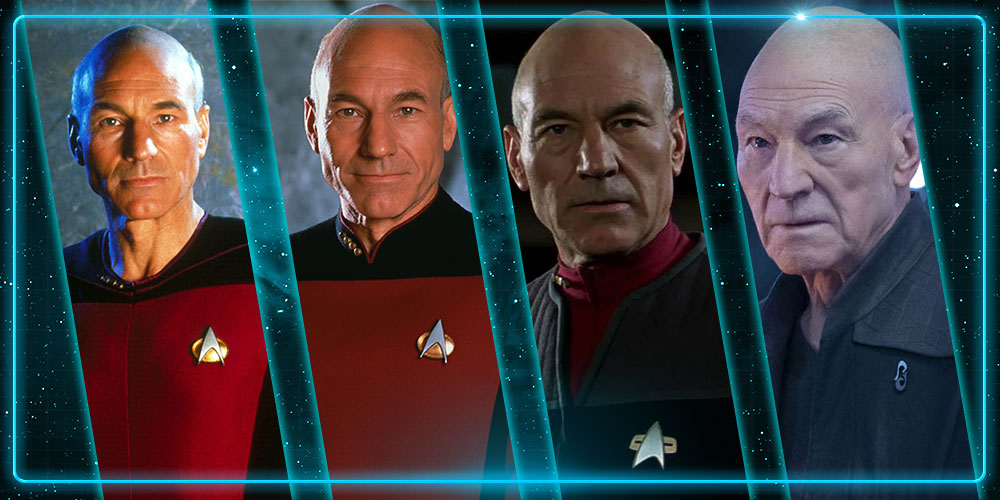Captain Jean-Luc Picard’s Era: 1989 (TNG S1) – Present (Star Trek: Picard)
There has been much discourse over the years as to the differences between Captain Kirk and his successor as captain of the starship Enterprise, Captain Jean-Luc Picard.
Certainly, much ground was covered in the field of gender studies in the intervening years between the first portrayal of Kirk and the first portrayal of Picard. Picard can be interpreted as an older, wiser, steadier version of Kirk.
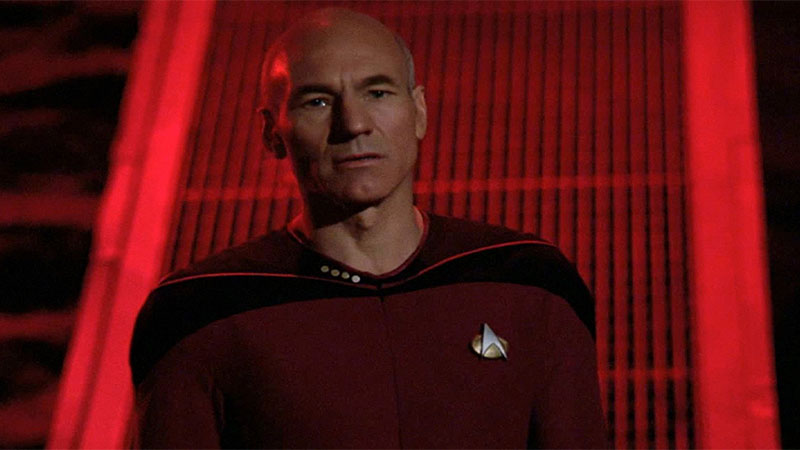
Picard, Renaissance Man
Although both men were intellectual and bookish, Picard’s masculinity was much more cerebral than Kirk’s, suggesting maturity and a seasoning. With his interests ranging from archaeology to music to performing Shakespeare, Picard is portrayed as a Renaissance Man. Picard did not sport a torn shirt after a fistfight in every episode the way Kirk did, although he could defend himself and his crew if called upon to do so.
Nor was Picard shown, as often as Kirk was, as an object of feminine desire. Like Kirk, Picard is uncomfortable around children. But as Kirk manages to provide fatherly counsel to Charlie X, Picard manages to overcome his discomfort to offer fatherly counsel to Wesley Crusher. Kirk is a self-defined soldier; Picard is a consummate diplomat.
Picard, the Consummate Diplomat
Consider the TNG episode “Ensigns of Command” in which Picard grapples with a densely written treaty and a species obsessed with legal red tape to successfully negotiate the lives of the colonists. Like Kirk, Picard is an explorer, an ambassador from the Federation to establish peaceful first contact with other worlds.
But unlike Kirk, Picard is reluctant to interfere in the natural development of those other worlds. There is a shift from Kirk’s paternalistic attitude toward cultures less advanced to Picard’s hands-off approach.
Picard is a man of peace, love, devotion to duty and to his crew, of fealty to the Starfleet in which he serves. Given over ten years of research into the aftermath of trauma that has preceded The Next Generation, as acknowledged in the presence of a counsellor on the Bridge, what changes do we see in the portrayal of Picard’s trauma?
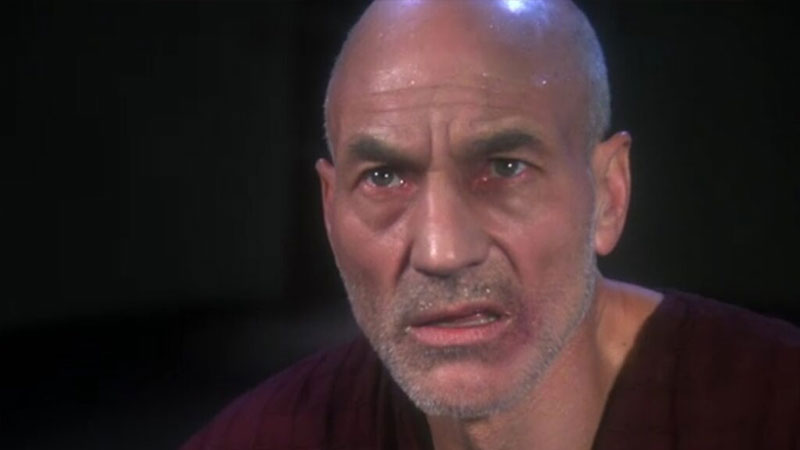
Chain of Command
The first real portrayal of trauma occurs in “Chain of Command, Part II.” In this episode, a Cardassian military commander employs several forms of psychological and physical torture to break Picard and none of those methods avail.
He cannot break Picard; he cannot obtain the information he wants. Although a deeply disturbing episode to watch, no consequences of Picard’s trauma are shown in later episodes.
Unlike another Captain portrayed in “The Wounded,” who suffers at the hands of the Cardassians and goes on to take an act of brutal revenge, Picard emerges from his trauma unscathed. He is back in the command chair as if nothing had happened, just as Kirk was following his survival of torture. Are people from the twenty-fourth century, then, immune to trauma?
The Best of Both Worlds
The two-part episode “The Best of Both Worlds” and the follow-up episode “Family” changed the portrayal of trauma and post-traumatic disorders in Star Trek forever. In this groundbreaking story, Picard is taken hostage by a race of cybernetic beings called the Borg. He is “assimilated” into their “collective”: that is, their hive mind.
Both his mind and his body are violated. There is nowhere for him to go to escape the trauma. As he lays on the table being assimilated, a single tear rolls down his cheek.
This is the very last sign of humanity from Picard until his rescue and recovery. All his agency and power and wisdom have been stripped away. His humanity has been overtaken by the Borg. He is forced to commit acts of atrocities that are completely foreign to his nature. He does not even have the option to die to prevent himself from being used against his people.
The straightforward heroism that was available to Kirk was not available to Picard. If Kirk corresponds to the WWII soldier fighting for a “just cause,” Picard corresponds to the Vietnam soldier being forced to fight for something completely abhorrent to his being.
Picard is rescued by his crew at the end of the episode. But for the first time in Star Trek history, his trauma does not end when the episode does.
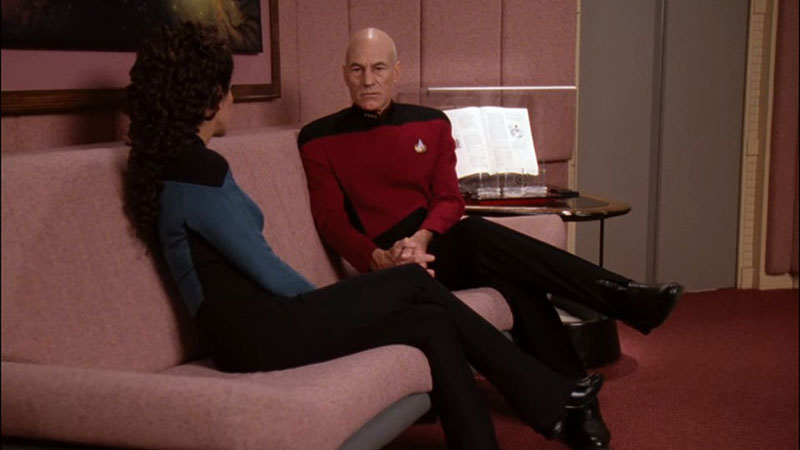
PTSD and Masculinity
To better understand the effects such trauma might have upon a man like Jean-Luc Picard, I turned to a collection of studies summarized and discussed by Elizabeth Neilson et al:
“a systematic review of traditional masculinity ideology— beliefs regarding the importance of men’s conformity to masculine norms—and PTSD among veterans and service members found that veterans’ expectations that men control and restrict their emotions were associated with PTSD symptoms severity. Trauma-exposed veterans may also engage in hypermasculine behaviours to reaffirm their sense of masculinity” (1).
The expectations regarding how male veterans respond to trauma and injury seemed most applicable to a starship captain, who is always expected to be in command, in control, and showing no weakness or distress. This behaviour, Neilson goes on to argue, exacerbates PTSD:
“Traditional gender norms may inform how veterans respond to traumatic experiences. Traumatic experiences, including combat trauma, prompt feelings of powerlessness and hopelessness that are antithetical to the societal expectation that men are powerful and in control. Thus, traumatic experiences may contribute to discrepancy strain of gender role strain” (3).
Family
This paper clarifies the follow-up episode, “Family.” Here, for the first time in Star Trek history, PTSD is portrayed realistically and movingly. Picard is reconsidering his fitness to command a starship because of his ongoing struggle with trauma.
After several counselling sessions with Counselor Troi, he visits his home and his brother Robert for the first time in many years, to try to heal and recover. But he and his brother have had an adversarial relationship for many years, and no amount of trauma can change that. Robert taunts his brother about his seeming invulnerability, and in an iconic scene, the brothers end up fighting in the mud of the vineyard.
This is the traditional masculine way of settling differences. But the fight is finally the catharsis Picard needs. Having proven his masculinity in a mud fight, he can finally weep openly and speak about his experiences for the first time:
“I tried so hard. But I wasn’t strong enough. I wasn’t good enough. I should have been able to stop them.”
This is the very root of his trauma: that a powerful starship captain was unable to stop a more powerful enemy.
Robert responds, “This is going to be with you a long time, Jean-Luc. A long time. You have a simple choice now: live with it [on an Earthbound assignment], or above the clouds with the Enterprise.”
This is the first acknowledgement within Star Trek that trauma isn’t just wiped away at the end of the episode, and the first time that manly violence is tempered with emotional catharsis.
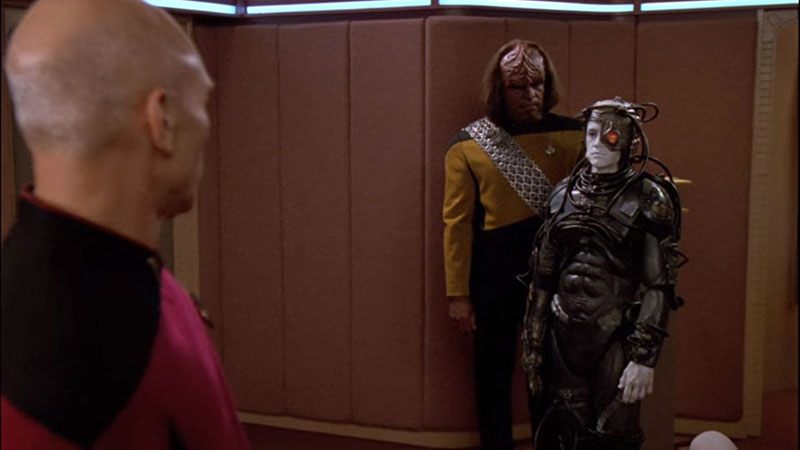
“I, Borg”
Picard, of course, chooses to learn to live with his trauma on the Enterprise. And this decision forces him to confront his trauma once again with the Borg. In the two-part episode “I, Borg,” the Enterprise crew rescues a single Borg drone that has become severed from the collective.
They save his life, and as the drone begins to reclaim his lost individuality, the crew begins to recognize the humanity in him. All, that is, except Picard. He is still too traumatized to see the Borg, who chose the name of “Hugh,” as anything other than a killing machine.
Yet with the opportunity in his hands to commit genocide against the Borg, Picard can, with the help of his crew, overcome his desire for external revenge. This can only be viewed as the progression of his healing journey.
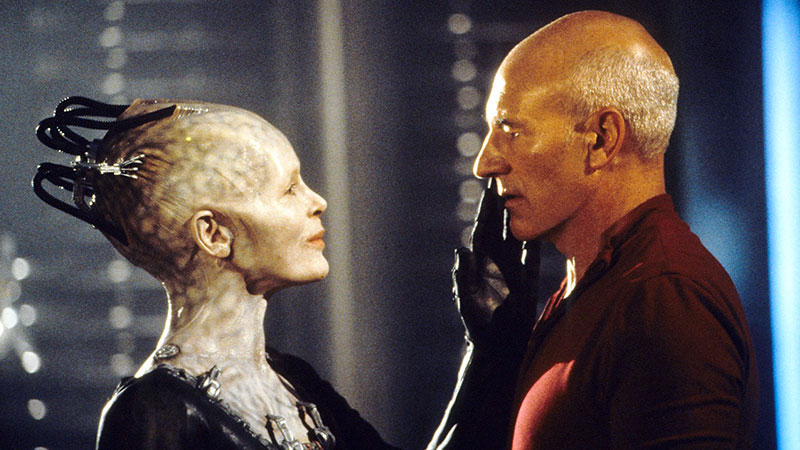
First Contact: A PTSD Film
Yet for as much progress as the television show made, from not acknowledging the long-term effects of trauma in Kirk’s era to dedicating an entire episode to it in Picard’s era, Star Trek does not completely depict complex dissociative PTSD until the 1996 movie, “First Contact.” This film portrays Picard experiencing the definitive PTSD symptoms: reexperiencing, avoidance, hyperarousal, and negative thoughts and feelings.
In his video commentary “Therapist Reacts to Star Trek: First Contact, Jonathan Decker, a licensed therapist who specializes in the treatment of trauma, provides insights into the portrayal of PTSD in the film.
He recognizes Picard’s visceral nightmares with which the film opens as the trauma response re-experiencing: “This is a trauma response. There is no escape from the trauma. When the client is asleep, all the trauma comes to the forefront. Nightmares are the place where the brain deals with things that we are unwilling to deal with when we are awake” (Decker). To comprehend the completely out-of-character behaviour that Picard exhibits throughout the film, we have to understand his trauma responses.
This film forces Picard to confront the Borg in a way he has not done since “Best of Both Worlds.” He is so filled with so much murderous rage that we cannot even recognize the pacifist intellect of the series. His only wish is to make the Borg pay for what they did to him. He avoids listening to the counsel of his trusted crew mates and his new companion, Lily, then he can avoid coming to terms with the pain.
Worf confronts him with the insight that he is allowing his personal experience with the Borg to cloud his judgment, and he responds with insults. He would rather seek revenge than choose a solution that would mean losing the Enterprise. “Picard has lost himself,” Decker notes. “He has become defined by his trauma.”
Picard eventually overcomes his trauma with the help of Data by defeating the Borg Queen and regaining control of the Enterprise. The video essay below “The Long Path: How Star Trek Handles Trauma and PTSD” by Jessie Earl is helpful to recognize the signs of PTSD in Picard, as well as to recognize his healing journey.
Addressing Picard’s character arc, from “Chain of Command” to “First Contact,” Earl suggests, “Healing from PTSD isn’t about overcoming it, but about working it into the definition of who you are. About reframing your relationship with your trauma, not ignoring it. What happened to you was not a choice. But what you do with that trauma is. It is only a part of who you are and does not have to define you (Jessie Earl).”
To be continued…
Author’s note: the following is the second of three sections from a research paper I wrote for my English Masculinities college course this spring. I’m very proud of my paper and wanted to share it with everyone.

